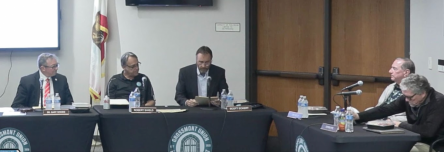
By Alex Schorr
Photo,Left to Right: Dr. Gary Woods (President, Area 3 Trustee), Robert Shield (Vice President, Area 4 Trustee), Scott Eckert (Clerk, Area 2 Trustee), Jim Kelly (Member, Area 5 Trustee), and Chris Fite (Member, Area 1 Trustee).
February 9, 2025 (El Cajon) – Teachers, parents, and community members leveled sharp criticism of the Grossmont Union High School District (GUHSD) board of trustees during a special budget workshop meeting on February 6. Numerous speakers objected to the board’s creation of a costly new chief of staff position and waiving of board policies to do so, after the board majority earlier voted to lay off numerous employees, including many teachers.
The first quarter of the meeting was dedicated to the Governing Board Budget. This involved showing where school funding comes from (sales tax, corporation tax, and personal income tax). California Governor Gavin Newsom developed a state budget while the district simultaneously project ts its own. In May, the Governor’s budget will be reviewed again, while the district budget will be adjusted and adopted sometime in June.
ts its own. In May, the Governor’s budget will be reviewed again, while the district budget will be adjusted and adopted sometime in June.
The Governor's proposed budget includes an education budget that invests in core instruction and learning. It also provides continuation for and protection of Proposition 98, which gives mandatory minimum funding for schools while eliminating “one-time funding.” Additionally, one-time funding was illustrated as having an impact on CTE program services, mental health, and chromebooks.
Photo, right: Deputy Superintendent of Business, Pearl Lizuka, introducing the Education Budget for GUHSD and the necessity of Proposition 98.
A staffer’s presentation at theGUHSD workshop illustrated that the greatest risk to Proposition 98 is declining enrollment. The presentation referenced the Local Funding Control Formula (LCFF), which revolves around the use of a Base Grant per ADA, stating that all English learning programs would be provided a 20% cut in funding. In addition to the GUHSD budget, a number of concerns could impact the state budget,including anxiety over stock market vulnerability, elevated interest rates, delayed tax deadlines, and federal policies centered on harsh immigration enforcement.
The podium was opened to public comment before the Board voted on agenda item D1, approval of a new job description for Chief of Staff, and D2, which waives board policies that allows them to accomplish D1.
James Messina, President of Grossmont Education Association (GEA), the district’s teacher’s union, asked, “What are we doing here?” He listed all laws and policies being broken if the Board voted to approve D1 and D2. He mentioned that the new position, if created or hired at all, is something that the Superintendent should be concerned with, not the Board members. Messina continued, stating that GUHSD used to be the envy of the county and that the board was ruining their reputation.
Additionally, Messina stated his concerns in a letter to GEA: “As GEA President, I would hope GUHSD would want to get the best possible candidate for this position, but it seemed more important to fill this position as soon as possible. This position was not flown in EdJoin for prospective applicants to see, [therefore] no applications to screen. GUHSD did not create a hiring panel for introduction level interviews. Finalists were not sent to the Superintendent for 2nd/3rd interviews. All of these steps were skipped and the Governing Board just appointed an employee for the new position. These actions of the Governing Board remove all transparency, go against past practice, GUHSD Governing Board bylaws, and GUHSD Board policies (BB 9900, BP4311).”
Other speakers included parents, teachers and community members stressing a lack of support and that in spite of this, the Board wants to add a new salaried position, which the governing board members have appointed all by themselves without going through the process of vetting, interviews, or the proper hiring processes.
Matthew Norris emphasized an undermining of trust, with Gavin Preston stating that the governing board members manufactured an emergency. Bonnie Price said the board trustees are degrading the quality of education in her district. It was emphasized that the most important job of the board is to annually assess how to make education better for the students, and that it was not clear how this new Chief of Staff position would do this.
Speakers from Monte Vista and Granite Hills high schools illustrated that the Board fired a number of people last year including at least ten teachers, stating that the budget required it. Yet suddenly this year, the Board acquires the money to hire a Chief of Staff who is essentially taking on the role of the fired individuals.
Multiple speakers accused board members of either sidestepping the legal process or downright ignoring it. These speakers brought attention to the fact that this would unnecessarily cost money and public trust.
Only two board members addressed concerns raised by speakers.
Trustee Jim Kelly gave this response. “I'm sure everyone’s minds are made up, and speaking as a 32 year board member, I can tell that this position is needed,” he stated. He indicated that the GUHSD bureaucracy needs to have better communications with the public: “the administration does a really good job at looking after itself, protecting itself, and filtering information that goes into the board,” adding that sometimes the board learns information later that might have resulted in a different decision if known earlier. “We come for one meeting a month, normally...and we’re flying blind,” he asserted, adding, “I have seen sometimes people come up to me saying they are afraid to talk to board members.”
Trustee Chris Fite said hiring the Chief of Staff in this manner would undermine the public trust. We don’t need this position,” said Fite,”and this is not the way we should be doing business.”
In the end, Dr. Gary Woods (President, Area 3), Robert Shield (Vice President, Area 4), Jim Kelly (Area 5 Trustee), and Scott Eckert (Clerk, Area 2) voted in favor of the new Chief of Staff Position, with Chris Fite, (Trustee, Area 1) voting no.

East County News Service
February 6, 2025 (Lakeside) -- The Barona Oaks Raceway, LLC is inviting review and public comments on a preliminary grant application to the state of California's Off-Highway Motor Vehicle Recreation (OHMVR) Division. The park is requesting funds for ground operations and maintenance and infrastructure development at the Barona MX Motocross Facility at 1800 Wildcat Canyon Rd, Lakeside, CA 92040 (www.barona-mx.com).
The grant application will be available online Tuesday March 4, 2025 at OHMVR Division. Public review and comment period is March 4, 2025 to May 5, 2025. Comments on the application must be submitted by 5 p.m. Pacific Standard Time on Monday May 5, 2025 to the applicant at baronaoakssportscenter@gmail.com and the OHMVR Division at OHV.Grants@parks.ca.gov.
The OHMVR grants and cooperative agreements program supports well-managed off-highway vehicle recreation in California by providing financial assistance to cities, counties, districts, federal agencies (including the BLM), state agencies, educational institutions, federally recognized Native American tribes, and non-profit entities. Information on the grant program is available at Welcome to the Off-Highway Motor Vehicle Recreation (OHMVR) Division’s Grant Programs.
Public comment meeting will be at the park Saturday Feb 15, 2025 at 10:00 a.m. and a Stakeholders meeting will be held at 2:30 p.m. The meeting will be at the park’s Main Track Firepit area.

By Mike Allen
Photo: construction at night for Advanced Water Purification program
February 6, 2025 (Santee) -- East County’s biggest infrastructure project, Advanced Water Purification, is officially costing more than $1 billion after the Joint Powers Authority that oversees it approved about $80 million in changes to its construction contract.
AWP, planned since 2015 to provide water reliability to the region, was initially estimated to cost about $500 million to build, but by 2021, its former CEO Alan Carlisle told the Santee City Council the new estimate for the program was “north of $600 million.”
Now the cost for construction packages 1 through 4 is more than twice the original estimate. And that’s not counting the cost for package 5, which hasn’t been disclosed because it’s still in the planning stages. However, documents on AWP’s website show an estimate between $100 million and $200 million for a system that converts waste to energy to power the new facility under construction at the end of Fanita Parkway in Santee.
The AWP’s hefty cost is being borne by four partner agencies: Padre Dam Municipal Water District, the city of El Cajon, San Diego County, and Helix Water District.
At the JPA’s November meeting when the amended contract was approved, board president Steve Goble noted the $80 million increase to package 4 was significantly above an original estimate for this phase of $100 million, and asked the reasons behind it. “The public would say that’s a big increase, an 80 percent increase,” he said.
 Photo, right: work on Advanced Water Purification near State Route 52
Photo, right: work on Advanced Water Purification near State Route 52
Rebecca Abbott, the project’s chief engineer, said, “It really boils down to project complexity…it’s what we know now versus what we knew then.”
Melissa McChesney, spokeswoman for Padre Dam WD, said in an email to East County Magazine the key reasons behind the increased costs for package 4 are the complexity of inserting two smaller sewer pipelines into an existing pipe; minimizing construction impacts which extended the construction time from 18 months to 34 months; and the increased costs for labor, materials and equipment rentals.
Among the more expensive elements is a requirement for a force pipeline connecting to the AWP facility to be operating through heavy rain events during construction and providing enhanced protection to Mission Trails Regional Park. Both added about $12 million to the bill. A Caltrans mandate to tunnel beneath State Route 52 added another $10 million, she said.
The good news for the participating agencies and their rate payers is that the city of San Diego is on the hook for most of the increased cost. The JPA’s share is about 39 percent, while the city assumes 61 percent of the residuals line cost, according to JPA documents. That share boosts the cost for the AWP by about $70 million, bringing the revised total for the project to about $1.02 billion, compared to the previous official estimate of $950 million.
All this work is being coordinated with the city as it moves ahead with its own water reclamation system called Pure Water, which will cost about $1.5 billion for Phase I, including the planning, design and construction. Construction on Phase I is over 70% complete. The city hasn’t revealed what the construction cost is.
Water agencies in Southern California have been building these expensive systems in the last several decades as the cost of imported water from Northern California skyrockets, but at least one longtime elected water official says the area doesn’t need it.
“I voted against (AWP) because there’s ample water in the area,” said Dan McMillan, who is a member of Helix Water District’s board and the San Diego County Water Authority.
Reacting to the higher costs, more customers have cut way back on their water use, resulting in surplus supply in much of the San Diego area, McMillan says. But all the water agencies need to maintain their systems, and the cost for doing that is always increasing so that results in water agencies hiking their fees.
While Helix is not a full-fledged partner agency in the JPA, the La Mesa-based Helix district is committed to purchasing about 30 percent of its water from the AWP, and a big part of the last phase of AWP’s purification process takes place at Helix’s Lake Jennings and the R.M. Levy Water Treatment Plant.
Goble, who also serves on the El Cajon City Council, said once AWP begins operating the cost for sewage removal now provided by San Diego’s Metro Wastewater should decrease. Under the current system, the JPA’s members “are essentially at Metro's mercy what rates will be charged, and Metro can include whatever costs it deems appropriate,” he said.
Goble said AWP’s water costs will be competitive with imported water now charged by the San Diego County Water Authority, while the sewage removal costs will be competitive with the current rates for sending wastewater to the Metropolitan Wastewater system. “The (AWP) program is a smart investment and will cost less than doing nothing,” he said.
While the AWP additional costs are concerning, Goble and other JPA directors said their concerns were allayed by the negotiated “guaranteed maximum price” for the construction contract that protects the agency and puts the risk for future overruns on the contractor, Orion Construction.
AWP officials often cite the project’s strong financials and its success in securing about $833 million in low interest loans and grants. The grants portion comes to $162 million. The program continues to apply for grants and has one pending at the state for its package 5 project, a waste to energy system.
Water officials who pushed for the AWP insist the ongoing cost of importing water from the northern part of the state makes creating a reliable, local supply a no-brainer. Along with higher costs for importing water are the increased costs from the city of San Diego to treat the sewage.
The plan is to take the 15 million gallons of sewage generated in the region daily that’s now sent to Metro Wastewater and convert it to some 11.5 million gallons of drinkable water for the region of more than 100,00 residents.
If the JPA doesn’t complete the AWP the Padre Dam WD will continue to rely on the San Diego County Water Authority to obtain all of its water, says PDWD Director Suzanne Till. For the 2023 fiscal year, the CWA raised the rates it charges its member agencies by 23.5 percent, but for the 2024-26 period that increase will be 39 percent, Till said in an email.
“Padre Dam can no longer be so dependent on SDCWA,” she said.
The big hike in AWP’s cost won’t affect the timetable for completion, McChesney said. The project is on schedule to be completed by the fall of this year. Following an extensive testing period, it will begin delivering water to users by late 2026, she said.
Correction: An earlier version of this draft indicated that Phase I costs cover planning and design. Phase I also includes construction.

Screenshot from YouTube video: suspect hurls shampoo bottle at employee
View videos:
https://www.instagram.com/daygotv/reel/DFgPb6JoFCl/
https://www.youtube.com/watch?v=MKPxJKrzI30
East County News Service
February 5, 2025 (Santee) – August Marriott, 27, has been arrested for becoming violent and threatening employees at a hair salon in Santee. On January 29, after being told he was late for an appointment at Great Clips on Mission Gorge Road, the man began hurling shampoo bottles at workers and knocking products off shelves. He shouted obscenities and repeatedly threatened harm to an employee.
The incident was captured on cell phone video and has been shared on various social media platforms.
"An employee suffered minor injuries,” says Sergeant Stephen Chambers with the San Diego County Sheriff’s department.
The man left the store before Sheriff's Deputies could arrive at the hair salon. He was identified thanks to many tips from the public.
On Tuesday, February 4, deputies from the Santee Sheriff's Station arrested Marriott in Chula Vista. He was booked at the San Diego Central Jail on numerous charges, including assault with a deadly weapon, vandalism and violation of parole.
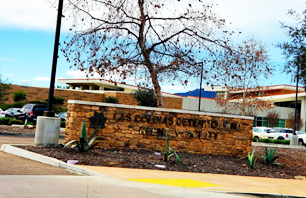
East County News Service
January 31, 2025 – Annette Smith, 58, of El Cajon has been arrested on suspicion of mailing a narcotic-laced greeting card into a San Diego County Jail.
In December 2024, deputies assigned to the Sheriff's Mail Processing Center intercepted a greeting card intended for Alicia Abungan, 52, who is in custody at the Las Colinas Detention and Reentry Facility in Santee. While inspecting the card, deputies noticed it had the appearance of being soaked in narcotics.
The Sheriff's Detention Investigations Unit began a criminal investigation, which identified Smith as responsible for mailing the greeting card containing narcotics.
On January 29, Sheriff's DIU Detectives along with deputies from the Lakeside Sheriff's Substation's Crime Suppression Team and Santee Sheriff's Station's Community Oriented Policing and Problem Solving Team served a search warrant at Smith's home in El Cajon.
“During the search, detectives found evidence related to the mail case and 35.67 grams of methamphetamine,”says Sergeant Aaron Brown.
Smith was arrested on numerous charges, including sending a controlled substance into jail. This is a felony charge with a penalty of up to six years in custody.

East County News Service
January 29, 2025 (Santee) – Bring your dog for fun times at Fido Fest, or adopt a furry companion from rescue groups. The city of Santee event will take place on Saturday, Feb. 22 from 11 a.m. to 3 p.m. at Town Center Community Park East, 550 Park Center Drive East in Santee.
Contests will be held for the biggest and smallest dogs, best costume, and best trick. There will also be “arfs” and crafts, demonstrations, off-leash areas, vendors and giveaways.
Dogs attending must be social and friendly with other dogs and people, and comfortable in large groups.
Dogs who display aggressive behavior, as determined by City of Santee volunteers or staff, will be asked to leave.
Dogs must be up to date on vaccinations. This means puppies must be over 4 months old and have completed their full set of puppy vaccinations, including rabies.
All dogs must be kept on a leash no longer than 6 feet at all times.
Dogs must also be ready to have a good time, exhibited by lots of tail wagging!
For a list of adoption groups and event details, visit https://www.cityofsanteeca.gov/calendar/events/fido-fest/45710.
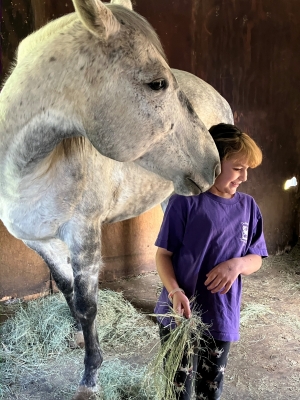
By Olivia Barnard
December 10, 2024 (Lakeside) -- I first met Robin Pawl and her horses Shelby, Indy, Ka Lio, and Phoenix on a Saturday afternoon. The faded Lakeside hills framed the riding center as hawks called out and the pepper trees swayed. I loved horses growing up, but I had never been on a ranch. I didn’t know what to expect from volunteering with horses or students with disabilities. But The Magic Horse website’s description of therapeutic riding practices was interesting, the place charming and intriguing, and I was going to give it a shot.
Upon meeting Robin and the horses, I couldn’t have predicted how much personal growth would come out of our experiences together. In sharing my experiences, I hope to inspire others to take the opportunity and discover the magic of the horse, just as I did.
My first day went as expected—I was on poop duty. Students were scheduled to arrive later that day, so until they did, I wouldn’t get to see what Robin described regarding the horses’ positive impact on her students. Robin explained on introduction day that The Magic Horse is a nonprofit she founded in 2004. Using her therapeutic riding instructor certification, background with horses, and expertise in Equine Assisted Learning (EAL) practices, she runs the center with volunteers. By joining the team, I could contribute to The Magic Horse’s mission statement goal to, “make a life-enhancing difference for people with disabilities and their families through the magic and power of the horse.” However, my first task was manual labor.
The experience was surprisingly meditative. I was out in the open, fresh air and felt the horses’ presence nearby. I welcomed the peace and connected with the environment and my body. Hand over hand, weight shifting between each leg as I lifted the rakefuls, I made steady, satisfying progress.
This initial task was the first interaction where I started to see the various and unique ways people can learn while working with horses. Even mucking out stalls off ered some unexpected yet important lessons. I saw how getting to the “fun” part of anything requires the completion of other necessary parts. All people at the Magic Horse know this. Volunteers must do chores. The students are taught that in order to ride, they have to prepare their horses. Everyone is expected to be detail-oriented and thorough, even when manual tasks aren’t exciting. These duties build responsibility, train the body, and inspire a feeling of fulfillment. Robin told me she grew up with horses and noticed how much it improved her strength, so now she helps people (especially kids) develop their physical skills through activities with the horses. She said, “Working with horses can increase physicality, balance, coordination, strength, and fine and gross motor skills. If you're tying knots or doing anything with your fingers, those are fine motor skills, while gross motor skills are the big motions, like carrying the brush bucket.” So simply from shoveling poop, I learned there’s a lot more to working with horses than just riding.
ered some unexpected yet important lessons. I saw how getting to the “fun” part of anything requires the completion of other necessary parts. All people at the Magic Horse know this. Volunteers must do chores. The students are taught that in order to ride, they have to prepare their horses. Everyone is expected to be detail-oriented and thorough, even when manual tasks aren’t exciting. These duties build responsibility, train the body, and inspire a feeling of fulfillment. Robin told me she grew up with horses and noticed how much it improved her strength, so now she helps people (especially kids) develop their physical skills through activities with the horses. She said, “Working with horses can increase physicality, balance, coordination, strength, and fine and gross motor skills. If you're tying knots or doing anything with your fingers, those are fine motor skills, while gross motor skills are the big motions, like carrying the brush bucket.” So simply from shoveling poop, I learned there’s a lot more to working with horses than just riding.
It’s these subtler yet equally engaging activities that form the basis for unmounted personal-growth opportunities like horsemanship training, EAL programs, and leadership-development courses. The difference between the three curriculums, which Robin offers students of all backgrounds, is that horsemanship courses focus on strengthening equine knowledge and familiarity. In the program offered by the The Magic Horse, students have hands-on experiences implementing equine training techniques and caring for horses. On the other hand, EAL group programs encourage participants to self-reflect and, with the unique assistance of horses, pursue growth in target skill areas. Leadership development is at the core of all things horses, and can be valuable when specifically focusing on team member contributions, cohesion, and individual composure.The insight I’ve gained has been from months of volunteering, but these styles of teaching accelerate the learning process. The experiences I share in this article are examples of the growth opportunities I’ve found. The Magic Horse offers a range of lessons for fostering self-awareness, growing confidence, practicing group cohesion, and implementing better leadership.
My first task at the Center helped me recognize the value horses can bring to one’s life. In the calm environment of the Magic Horse grounds, I self-reflect and slow down from my busy college-student life. I appreciate the simple things in life, but also find mental clarity to move deliberately toward my goals. Interestingly, the attitudes each person adopts are reflected in the horses, allowing one to increase their self-awareness.
Early on, I heard Robin tell a volunteer who was tense that horses are herd animals and liken their feelings to those they’re working with. Robin explained the 7-4-8 breathing technique and told the volunteer that if she calmed herself, her horse would become less agitated too. As I watched the volunteer and horse relax, I reflected on my own body and where I was holding stress. A big part of being around horses, where body language is key, is recognizing that body and mind are connected forces. Bodily and situational awareness go together as a way to connect to one’s emotional well-being, as well as an accompanying horse’s. Robin would later tell me, “Our bodies can affect our thoughts, and our thoughts affect our bodies. So if we put ourselves into a different posture, it can help change our thinking and feeling. Horses are the same way. If we can encourage them to have a more correct and relaxed body posture, then they can relax in their mind.” In the following weeks, I noticed my own emotions reflected by the horses. Sheila, a volunteer of 17 years and lifetime horse owner, explained how she feels a special emotional connection to horses. “Horses seem to know your heart in a way that other animals don't,” she said. Though I’d gained a lot from my solo poop-scooping adventures, it was exciting to begin working with other volunteers. Nanami, Aleah, and I work together almost every week and have formed a friendship through our teamwork. We discuss our student lives in our respective high school and grad/undergrad programs, but we also share what we’ve learned from the horses.
Though I’d gained a lot from my solo poop-scooping adventures, it was exciting to begin working with other volunteers. Nanami, Aleah, and I work together almost every week and have formed a friendship through our teamwork. We discuss our student lives in our respective high school and grad/undergrad programs, but we also share what we’ve learned from the horses.
All of us have seen an increase in our level of confidence around the horses. At The Magic Horse, all participants learn the ins-and-outs of horse ownership and gain problem-solving and adaptability skills in getting the horses to cooperate. In one frustrating encounter, our objective was to muck Phoenix’s pen out. However, Phoenix is the most dominant horse at the center and tested our will by continually getting in the way. It took our combined volunteer forces to repeatedly shoo him back into his barn, where he eventually stayed for good. In this practice, we had to be persistent and unyielding. Gaining confidence around an incredibly dominant horse is difficult, especially with no equestrian background. However, by taking initiative consistently, self-efficacy can flourish. Its about setting intentions (cleaning the pen) and taking the necessary steps (shooing Phoenix) to reach the goal. Horses sense hesitation. They won’t follow through if you don’t. You improve when you persevere.
It’s through persistence that students like Annabella thrive. Annabella, who is diagnosed to be on the autistic spectrum, has been riding for eight years. In her time at the Magic Horse, she’s gained a deep understanding of horses and more importantly, a better sense of herself and her goals. Her mother Heidi described how amazing it is to see her daughter persevere, saying “Annabella has had a tendency to give up very easily when something's physically hard. Robin challenged her to keep trying. When I first came here she could not do buckles; now, she can almost fully tack up the horse by herself.” I realized the power of the horse when I saw Annabella in her element. In a family of five children, it is through horses that Annabella has found her niche and taken control of her life instead of others telling her what to do. “Horses have been Annabella’s way of self-mastery. She has learned that she can do so much more than she thought she could and more than I thought she could,” Heidi said.
Another student who’s made incredible progress is two-year-old Alden. Alden is bubbly and curious. He’s always smiling, babbling, and exploring. However, he wasn’t always able to express his feelings verbally or walk around on his own. After three months on the horses, Alde n gained the ability to walk 38 independent steps and strengthened his verbal skills. Robin explained that this process can be very rapid. “Sitting on a horse stimulates children’s bodies to develop so they can start walking. It also stimulates their ability to speak, so kids who are nonverbal can often speak their first words when they're on the horse. Once that starts, it usually keeps going, and pretty soon they’ll be talking up a storm. And then parents wonder, ‘Oh, why did I ever want him totalk?’ They’ll start to walk, and pretty soon they're running. It's like, ‘Oh my gosh, now, we have to chase after them!’” she said.
n gained the ability to walk 38 independent steps and strengthened his verbal skills. Robin explained that this process can be very rapid. “Sitting on a horse stimulates children’s bodies to develop so they can start walking. It also stimulates their ability to speak, so kids who are nonverbal can often speak their first words when they're on the horse. Once that starts, it usually keeps going, and pretty soon they’ll be talking up a storm. And then parents wonder, ‘Oh, why did I ever want him totalk?’ They’ll start to walk, and pretty soon they're running. It's like, ‘Oh my gosh, now, we have to chase after them!’” she said.
This type of progress fundamentally alters how children interact with the world, but in freedom, new challenges arise for parents and teachers. Alden’s curiosity is sometimes a source of distraction from goals set by his parents and teachers. Jake, another student, is happy to participate in conversations with volunteers, but these tangents can interrupt lesson plans. In these situations, I’ve gained the ability to recognize and understand other perspectives. Robin gets riding lessons back on track not by brashly making demands but by acknowledging distractions and then redirecting the students’ focus. This approach is also important in working with horses. Horses are prey animals and constantly keep track of their environment, and thus may act in confusing ways that aren’t compatible with the handler’s desires. But I’ve learned in my experience with both people and horses that it’s through taking other viewpoints into account that harmony can be realized. No understanding comes out of simply forcing ones way onto others. Robin wants her horses to keep their personalities. Their dispositions are what make them unique and provide opportunities for people to learn new social skills. She said, “When horses are forced against their will to be something they aren’t, they’ll shut down and become robotic. I want my horses responsive,” said Robin.
Working with horses provides unique experiential learning opportunities in team building and communication. A crucial part to working with horses is to align intentions, words, and actions consistently. This alignment is applicable when strengthening the communication in any r elationship. Clear communication also promotes fairness. When people contradict themselves in voice and action, it is not fair that the others are punished for misunderstanding. Trust and collaborative relationships can develop between horses and people in horsemanship exercises like round penning.
elationship. Clear communication also promotes fairness. When people contradict themselves in voice and action, it is not fair that the others are punished for misunderstanding. Trust and collaborative relationships can develop between horses and people in horsemanship exercises like round penning.
Round penning requires great equine-human communication, a fair hand, and close physical proximity. When I first entered the pen, I was intimidated by the idea commanding a creature weighing six times more than I did. However, the experience turned out to be incredibly fascinating and rewarding. In a single session with Robin and Shelby, I was able to considerably increase my knowledge of horse language while discovering my own communication and leadership styles.
These interactions are even more amazing when put into context. Shelby is not a bad horse, but he is certainly disobedient and obnoxious in many situations. In the round pen, however, Shelby is well-behaved and a great instructor and partner. He provides feedback when the rules are broken by the student, but, like the other horses, he is forgiving of mistakes and unclear communication. It’s Shelby’s general bad manners though that set him apart from the other horses who act according to their position within the herd hierarchy.
When I arrived at The Magic Horse, what became evident immediately was that horses are unlike other domestic animals. While Maestro the dog was easy to warm to, and Indy the horse was generally interested in being scratched by anyone, Ka Lio and Phoenix made it clear their respect had to be earned. Power and social standing are critical themes in working with horses. Effective leadership and boundary-setting are crucial to gaining horse cooperation.
In my first interaction with Phoenix, he nipped me on the butt. However, it wasn’t out of aggression or the desire to misbehave. The nip was the secondary part to his testing my reaction after he had already entered my personal space. Because I didn’t take charge immediately and move him, he knew he could have his way. With horses, it’s a matter of establishing rules. “You have to set boundaries. Horses are social animals. They understand boundaries. You have to uphold them,” said Robin. Standing tall and adopting a no-nonsense but fair attitude can make all the difference.
Therefore, because herd structures rely so heavily on good leadership and social hierarchy, they can be the ultimate teachers of how to earn and wield authority. What’s important to first understand is each group members’ position and resulting conduct which has to do with mindfulness of oneself and others. Robin explained when strengthening leadership skills through EAL practices and horsemanship drill s, she pairs individuals to specific horses. She said, “A person who is too timid can't be with a super assertive horse without learning how to deal with a super assertive horse. A horse’s reaction will show when someone comes across too assertively and when one does not come across assertively enough to enforce boundaries.” When Aleah, Nanami, and I moved Phoenix, we needed to take on a more dominant approach than when working with Indy who is far more submissive. In working with horses, volunteers and students learn how to be leaders that earn respect while staying polite and fair. “If you are a good leader, you're fair and just, and you're consistent, then a horse will be willing to follow your lead. In general, adapting yourself to other personalities, abilities, and communication styles is important. You learn to shift your leadership style to be effective. So when you're working with a horse, you have to recognize where in the hierarchy of power this horse sees himself. You have to be a little more powerful than he is, so that you can manage him. If you're not, he's going to manage you,” said Robin.
s, she pairs individuals to specific horses. She said, “A person who is too timid can't be with a super assertive horse without learning how to deal with a super assertive horse. A horse’s reaction will show when someone comes across too assertively and when one does not come across assertively enough to enforce boundaries.” When Aleah, Nanami, and I moved Phoenix, we needed to take on a more dominant approach than when working with Indy who is far more submissive. In working with horses, volunteers and students learn how to be leaders that earn respect while staying polite and fair. “If you are a good leader, you're fair and just, and you're consistent, then a horse will be willing to follow your lead. In general, adapting yourself to other personalities, abilities, and communication styles is important. You learn to shift your leadership style to be effective. So when you're working with a horse, you have to recognize where in the hierarchy of power this horse sees himself. You have to be a little more powerful than he is, so that you can manage him. If you're not, he's going to manage you,” said Robin.
Since volunteering at The Magic Horse I’ve gained invaluable knowledge about myself and the world around me. Observing the interactions between Robin, the horses, students, parents, and other volunteers has proven incredibly beneficial to how I view my relationship with myself, others, and the world. The experiences I’ve shared with people and horses while upkeeping the grounds, providing equine care, and taking on horsemanship practices have contributed to immense personal progress in varying skill areas. I’ve increased my self-awareness, strengthened my ability to take initiative and persist, become more compassionate and flexible, gained valuable communication skills, and realized how I can become a better leader. My experiences are unique in how they’ve affected me, but the lessons I’ve learned are not exclusive to my role as a volunteer. The magic of the horse can be shared with individuals of all ages and abilities, but only if Robin’s efforts are supported by volunteers, donors, and students. Great commitments of time and money keep The Magic Horse running. However, the space is only preserved and able to continue benefiting the community as long as it is sustained by caring individuals. Overhead costs continue to rise, and The Magic Horse needs support now as Robin introduces three new programs based on the core concepts she’s been teaching for years.
Moving forward, Robin invites students of all ages, abilities, and backgrounds to visit the center and experience some of the magic firsthand. Reflecting on what I’ve seen, I believe there’s truly something of value here for everyone. If you are interested in learning more about the center, you can go to https://www.magichorse.org/ and schedule a visit. I’m excited to work with all prospective volunteers and students, whether you’re interested in therapeutic riding lessons or the three new programs: group unmounted EAL sessions, horsemanship lessons, or leadership programming (further information for the programs is listed below). But most of all, I’m glad that I’ve been able to contribute to keeping the magic of the horse alive and share it with others. Sheila, a volunteer of 17 years, said it best, “I know what horses have given me, and it's good to see other people getting that too.”
________________
Group Unmounted EAL Sessions: For groups of up to six interested in general horse care and social interaction opportunities, the center offers one-hour sessions of unmounted group equine assisted learning (EAL). This program provides an education in grooming, feeding, health and ailments, and first aid. With hands-on experience learners have the opportunity to connect with horses in a peaceful setting and develop personal goals and specific skills. While participating in fun activities with the horses, they’ll observe and practice aspects of equine communication to better understand their own body language and interactions with others. This program allows groups of individuals to learn through Robin’s storytelling and focus on their personal wellbeing with practices, such as simultaneously calming oneself and the horse.
Horsemanship Course: This course is oriented towards prospective horse owners and those interested in receiving a thorough equine education. It is not recommended for kids. This program is available for groups of four or less and expands upon the individual-oriented teachings of unmounted EAL to offer groundwork experiences focused on horse training. Groundwork is an essential part of building a deeper connection with horses and includes multiple exercises, including round penning, leading, lunge lining, work in hand, and long lining. These activities provide a strong basis for building confidence around horses and applying effective communication practices. Working with horses in such an engaging way creates a solid foundation in understanding how to foster true cooperation and teamwork.
Leadership Program: This leadership course is composed of four 4-hour sessions and is most applicable to groups of individuals interested in personal development and improving work performance. Groups of four to eight members can engage in a variety of activities that foster leadership and team growth—no previous equine experience needed. In this unmounted program, individuals can learn leadership styles to become more influential and contribute to improved team dynamics. Learners will become aware of themselves and others as they analyze their relationships.

By Mike Allen
Photo: Winners of 10K race: 1) Celina Lepe-Corvera 2) Mina Shull 3) Johanna Flipsen. All photos by Mike Allen
January 13, 2025 (Santee) -- Under sun drenched skies, some of the best race walkers in the world shattered several records as they traversed the Santee Trolley Square course on Jan. 12.
The USA Track & Field National event featured competition in 35 kilometers, 20K, 10K, 5K, and 3K for both men and women.
The overall 35K winner, Perseus Karlstrom of Torshalla, Sweden crossed the finish line in 2:27:19, nearly 17 minutes faster than the previous course record. Karlstrom, 34, is the winner of multiple medals in both the World Track & Field Championships and other major races. A three-time Olympic athlete, he is gearing up for the 2026 Los Angeles Olympic Games. He took $8,000 for his first-place finish.
He was followed by Mexico’s Ever Jair Palma Oliveres, 32, and Nick Christie, 33 from El Cajon, who finished at 2:45:31. Christie holds the U.S. record for the event and took $4,000 for his third-place finish.
 Photo, right: women’s Winner of 35K race: Valeria Ortuna Martinez of Mexico City, MEXICO. Her time of 2:51:33 was nearly 6 minutes faster than previous record.
Photo, right: women’s Winner of 35K race: Valeria Ortuna Martinez of Mexico City, MEXICO. Her time of 2:51:33 was nearly 6 minutes faster than previous record.
The women’s 35K winner was Valeria Ortuna Martinez, 26, of Mexico City, who finished in 2:51:33, breaking the course record by nearly six minutes. She was followed by Nadia Gonzalez, 27, of Toluca, Mexico, and Olivia Lundman, 22, of Vancouver, Canada.
The USA Championship women’s winner was Katie Burnett,36, of Bellevue, WA.
Santee City Manager Marlene Best said the city was honored to host both the US Championships and International Race Walk Invitationals 15 of the past 17 years. “We love being the race walk capital of the United States!”
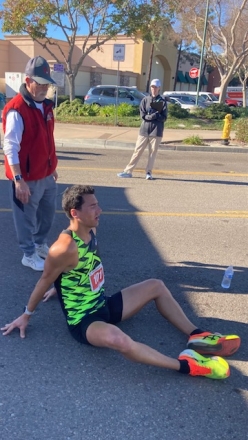 Photo, left: the winner of the men's 35K championship Perseus Karlstrom of Sweden shattered the previous record for this event by nearly 17 mins at 2:27:19. Seen here after collapsing at the finish line. Karlstom is a professional athlete who has competed at three Olympic Games, three World Championships, and is gearing up for the 2026 Los Angeles Olympic Games.
Photo, left: the winner of the men's 35K championship Perseus Karlstrom of Sweden shattered the previous record for this event by nearly 17 mins at 2:27:19. Seen here after collapsing at the finish line. Karlstom is a professional athlete who has competed at three Olympic Games, three World Championships, and is gearing up for the 2026 Los Angeles Olympic Games.
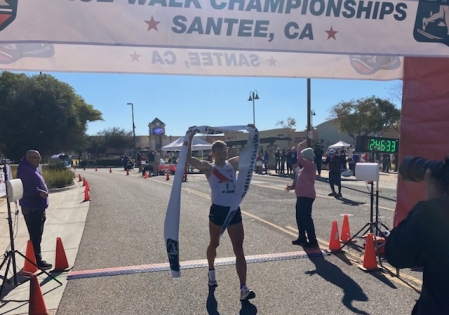 Photo, right: El Cajon’s Nick Christie, the best American race walker, finished third in the 35K race. First was Perseus Karlstom of Sweden and second was Ever Jair Palma Olivares of Mexico.
Photo, right: El Cajon’s Nick Christie, the best American race walker, finished third in the 35K race. First was Perseus Karlstom of Sweden and second was Ever Jair Palma Olivares of Mexico.

Source: SDG&E
January 6, 2025 (San Diego) – Due to extreme fire weather conditions and forecasted Santa Ana winds, San Diego Gas & Electric Company (SDG&E) has notified 64,866 customers that it may have to turn off power to reduce wildfire risk as early as Tuesday. Public Safety Power Shutoffs (PSPS) are approved by state regulators as an important safety tool of last resort to mitigate fire risk during dangerous weather conditions.
This week marks the driest start to the rainy season in San Diego County in 174 years. As a result of these dry conditions and expected Santa Ana winds, the National Weather Service has issued a Red Flag Warning for parts of Orange and San Diego Counties beginning Tuesday evening through late Wednesday night. SDG&E’s meteorology team is closely monitoring weather conditions.
Power shutoffs are possible in the following areas:
- Alpine
- Barona Reservation
- Boulevard
- Campo
- Campo Reservation
- Capitan Grande Reservation
- Chula Vista
- Descanso
- East San Juan Cap
- El Cajon
- Escondido
- Fallbrook
- Jacumba
- Jamul
- Julian
- La Jolla Reservation
- La Mesa
- La Posta Reservation
- Lakeside
- Los Coyotes Reservation
- Manzanita Reservation
- Mesa Grande Reservation
- Pala
- Pala Reservation
- Pauma and Yuima Reservation
- Pauma Valley
- Pechanga Reservation
- Poway
- Ramona
- Ranchita
- Rancho Bernardo
- Rancho Santa Fe
- Rincon Reservation
- San Diego
- San Pasqual Reservation
- Santa Ysabel
- Santa Ysabel Reservation
- Santee
- Sycuan Reservation
- Valley Center
- Viejas Reservation
- Warner Springs
SDG&E has activated its Emergency Operations Center and staffed it with key personnel to monitor weather conditions throughout the duration of the event, especially the wind speeds in the high fire risk areas of the county.
If SDG&E implements a PSPS for public safety, it will open Community Resource Centers to support impacted customers.
Given the potential for extended power outages, SDG&E encourages customers to be prepared. Outage preparedness tips can be found at sdge.com/outage-center; safety guidelines for generator use can be found at sdge.com/generator.
Never approach a downed line; report it by calling 911 or SGD&E’s call center at 800-411-7343.
Real-time information about unplanned power outages can be found at www.sdge.com/outage.
Updates about this PSPS can be found at sdge.com/Ready and SDGEToday.com or by following SDG&E’s X channel, @SDGE.

East County News Service
February 2, 2025 (Santee) - Key of She, a 12 woman choral group, is presenting a free concert on Sunday March 2, at 2 p.m. at the Carlton Hills Lutheran Church at 9735 Halberns Blvd in Santee. The repertoire is an eclectic blend of classical and contemporary pieces. Some a cappella and some accompanied, to cover all tastes in music.
You’re invited to join the Key of She in their first appearance “East of I-15."
You can hear previous performances on their website: KeyOfShe.org.